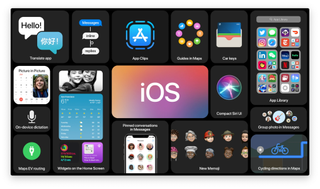10 years ago today, the App Store changed everything
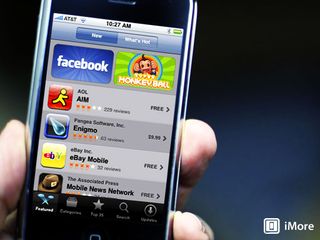
10 years ago today, Apple launched the App Store, and it's not hyperbole to say that, since then, nothing has ever been the same. Not for apps, which went from being scarce, niche products to part of popular culture like movies and music. And not for app development, which went from being something only a relatively few people did to something available and accessible to almost everyone.
The Dark Age of Apps
Before the iPhone and the App Store, there were a bunch of different web-based software fiefdoms for PalmOS, BlackBerry, Symbian, and Windows Mobile that collected a hodgepodge of different freeware, shareware, and commercial programs. They were attached to a variety of check-out systems, employed inconsistent and often annoying licensing schemes, and required a lot of work to install and make work. They were expensive by today's standards. And they often and took your device down with them.
Then came the iPhone.
Becoming the App Store
There were no third-party apps for it at first. That's led to some weird urban myths about Steve Jobs not wanting them or somehow having to be convinced or cajoled into doing it.
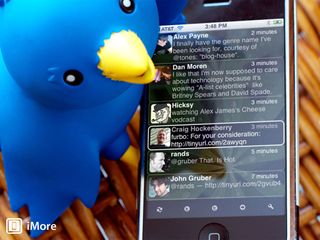
That's not true. Apple is a platform company. Jobs knew the potential of iPhone-as-a-platform from the start. In fact, it's more likely Jobs had to be convinced to release the iPhone before a platform strategy was in place.
It took everything Apple had to get the original iPhone out the door in June of 2007. There was literally nothing and no-one left to even plan a platform strategy. Not for year one. And everyone was so exhausted, year two looked iffy as well.
That's why Apple tried to buy some time with the "sweet solution" of Web 2.0 apps. Web apps were a known quantity by then so it took very little time to spin them up for iPhone. But, they landed with such a thud everyone, internally and externally, immediately realized there was no putting off native apps. They had to happen and fast.
Master your iPhone in minutes
iMore offers spot-on advice and guidance from our team of experts, with decades of Apple device experience to lean on. Learn more with iMore!
So, barely finished the marathon of sprints that was the original launch, the iPhone team had to begin a second one — towards apps.
Apple wanted apps to be safe, secure, and simple, so people could get them easily and trust they'd never crash the phone or the network, or exploit or infect them in any way.
There was some initial discussions about using AppKit, the Mac's framework, or WebKit, which powered Safari. Ultimately, Apple decided on something new: UIKit and the App Store.
On October 7, 2007, came the open letter from Steve Jobs:
Let me just say it: We want native third party applications on the iPhone, and we plan to have an SDK in developers hands in February. We are excited about creating a vibrant third-party developer community around the iPhone and enabling hundreds of new applications for our users. With our revolutionary multi-touch interface, powerful hardware and advanced software architecture, we believe we have created the best mobile platform ever for developers.
And then, on March 6, 2008, the iPhone SDK event.
The App Store was to be a centralized place on the Home screen of every iPhone where developers could submit their apps and users could download or buy them.
Developers would get 70% and Appel 30%, which would pay for vetting, hosting, transactions, marketing, and would also subsidize free apps, which increased the total value for customers — basically, buy a few paid apps, get a bunch more for free.
It launched on June 10, 2008, alongside the iPhone 3G, with Super Monkey Ball, Twitterrific, Facebook, AOL Messenger, Trism, Instapaper, and, again, cliche as it sounds, nothing has ever been the same.
Mac has an App Store now. Windows has an app store now. Android. Amazon. Facebook. Everybody has an app store. It's become the way apps are distributed to everybody, not just nerds.
The age of pop apps had begun.
Triumph and turbulence
To say it was akin to what iTunes had done to music by disintegrating the album or CD and selling songs for a dollar is an understatement.
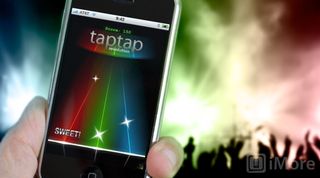
Scarcity disappeared. Apps went from the hundreds to the thousands to the millions. Pricing also got crushed as people went from downloading maybe a few high-priced apps a year, if that, to maybe wanting to download multiple new apps every week… every day.
There was a lot of turbulence for a lot of years, as customers started waiting for sales or sticking to free apps. Developers started cutting prices and cutting them again or figuring out that no one would pay $10 for a game but some people would pay that and more for the ego and instant gratification of having a better farm than their friends or getting their car back on the track faster.
Some developers held the line, even competing with free alternatives from Apple or Twitter or Google. Pcalc, Fantastical, Twitterrific and Tweetbot, Carrot and Weatherline, Omnifocus and Things, Halide and Obscura, Drafts and Agenda — indies proved that year in, year out, there was still a market for the best of the best of handcrafted apps.
I don't look at them so much as paid apps but as investments in the features and services I want to use and keep using going forward. A couple bucks here or there doesn't really matter. Having them shut down or go away would matter a great deal.
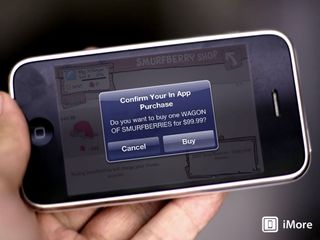
Just look at the apps that gave into VC-backed pump-and-dump social schemes or almost unplayable freemium models.
And even though some called the App Store restrictive and perpetually predicted doom and gloom, no competing app store, no matter how open its policies, managed to produce compelling apps the App Store couldn't. In fact, many of the most intriguing apps of the last decade, including Instagram, Uber, and Workflow, all debuted in the App Store.
There have been other crossroads as well. Back around the time of iOS 6, some felt the iPhone and App Store were essentially feature complete. That introducing more powerful functionality would require more complexity and make the devices less accessible for the mainstream. Others believed there was still a huge opportunity. That iOS could evolve to do things the Mac did, not the way the Mac did them, but in its own way.
That's how we went from having features like AirDrop repeatedly rejected to having Continuity, Extensibility, and better background APIs ship as part of iOS 8. Things we not only take for granted now but most of us couldn't do without.
The App Store also transitioned from being under the joint pervue of Eddy Cue, who ran services, business management, and editorial, and Phil Schiller, who ran marketing, review, and developer relations, to being complete under Schiller.
Making the App Store accountable to a single senior vice president, and a single senior vice president accountable for the App Store, helped a lot of the problems of the past get fixed, and get it moving towards a better future, including a huge redesign in iOS 11.
And now we have subscriptions and many apps are trying them, but it's unclear how many concurrent subscriptions customers will be willing to take on. That's where bundling may come back into play, both for media types and across them.
It became clear financially long before it did emotionally: Just making an app or service wasn't enough. Within a matter of years, zero points were left for novelty, let alone simple participation. It became entirely about showing value upfront and over time.
Like any industry going from obscurity to maturity, there were and are a lot of growing pains. Both from Apple, in terms of fixing app review, providing better tools and metrics, and creating new feature streams for developers to tap into, and from developers themselves who had to realize the gold rush had never been real, the lottery was hard to win, mining was never as rewarding as farming, and real success took real work.
This was especially true as Apple added things like Extensibility and now Siri Shortcuts, which break apart the old, branded binary blobs and start surfacing functionality where and when customers want to use it.
Very soon, if not already, we'll be telling our devices what we want them to do and they'll be doing it.
Apps then and now
A few years ago, if you'd gone to a website or app and needed to enter your long, strong, unique password, you'd have had to press the Home button, go back to the Home screen, find and launch your password manager, type in your authentication, find your login, copy it, go back to the app or website, paste it in, and maybe repeat the process again for your username. And that's after Apple added copy/paste and multitasking.
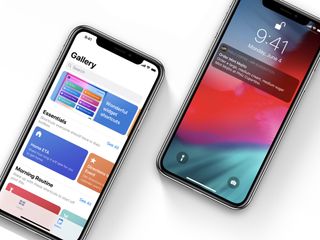
Eventually, with extensibility, in websites, you could call up the share sheet, fire up an action item, and inject your credentials right into the fields. You didn't need to even launch your password manager anymore, and with Touch ID and Face ID, your biometrics became your authentication.
Now, with the Password Manager API, you'll be able to autofill into websites and apps without even calling up the share sheet.
Same with photos. Previously, you had to bounce from app to app, loading an image each time, editing or filtering it, saving it, and bouncing to another app or apps, before going to your social network or sharing site and uploading it.
Eventually, with photo extensions, you could stay in Photos, call up the filters and effects from any or all your other editing apps, apply them nondestructively, then tap the share button and send it anywhere you want.
Now, with Shortcuts, you'll just say "Apply my styles" and your latest photo will get your signature look and be uploaded without you tapping a button.
Appy Anniversary
We're at the beginning of the next great revolution in apps. One that, given another ten years — hell, maybe even just a few — could make the apps we have today as unrecognizable in the future as the shrink-wrapped boxed apps of the past are today.
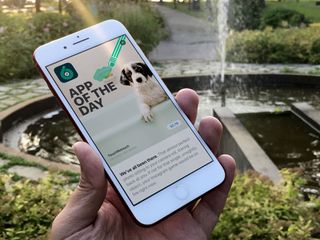
That's the real power of the App Store. Not what apps can do but what apps are. Not what developers can do but who can be a developer.
A little icon on the Home screen that gives birth not just to other apps but to all our collective needs and dreams.
And it all launched ten years ago today.
Happy birthday, App Store, to all the teams at Apple past and present that made and continue to make it possible, to all the developers then and now who filled and continue to fill it with previously unimaginable creativity and functionality, and to everyone who uses the App Store every day and helps shape what it becomes next.

Rene Ritchie is one of the most respected Apple analysts in the business, reaching a combined audience of over 40 million readers a month. His YouTube channel, Vector, has over 90 thousand subscribers and 14 million views and his podcasts, including Debug, have been downloaded over 20 million times. He also regularly co-hosts MacBreak Weekly for the TWiT network and co-hosted CES Live! and Talk Mobile. Based in Montreal, Rene is a former director of product marketing, web developer, and graphic designer. He's authored several books and appeared on numerous television and radio segments to discuss Apple and the technology industry. When not working, he likes to cook, grapple, and spend time with his friends and family.
Most Popular






